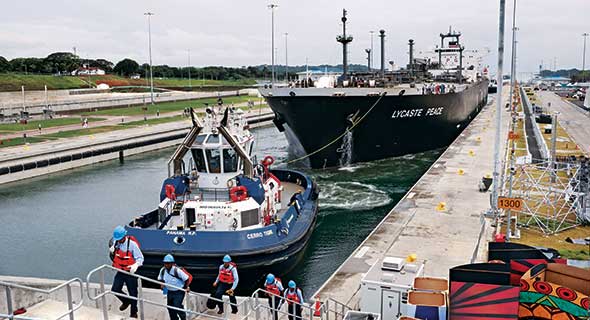Panama Canal helps deliver US propane to Asia

The very large gas carrier Lycaste Peace, owned by Japanese shipping company Nippon Yusen Kaisha, was the first liquefied petroleum gas vessel through the canal’s new locks. Photos courtesy of the Panama Canal Authority
The expanded Panama Canal is now open for commercial transit, and a very large gas carrier (VLGC) transporting liquefied petroleum gas (LPG) was among the first tankers through the canal’s new locks.
That an LPG tanker was among the first through the passageway is no coincidence, says Mike Sloan, principal at ICF International.
“LPG was certainly one of the cargoes the Panama Canal Authority targeted with the expansion of the canal, and it makes a lot of sense,” Sloan says. “If you’re looking at common routes for propane exports from the Gulf Coast of the United States to Japan, China or other Asia markets, the canal is certainly one of the key routes.”
The expanded Panama Canal isn’t expected to significantly increase propane exports in the short term, Sloan says. But having a third set of locks – one that can accommodate the VLGCs that play a role in taking propane offshore – should slightly lower the cost of transporting the fuel to Asia.

U.S. propane exports to South America have been on the rise since 2010. Below: Most petroleum traffic through the Panama Canal moved southbound last year.
“You’re not going to see as much of a cost reduction from using the canal as you might think, given the savings and the amount of time,” Sloan says. “The Panama Canal Authority is going to try to capture as much of that value as they can. Of course, they’ll make certain they’re splitting the profits with the shippers so the shippers still have a significant incentive to use the canal. But like pricing anything, it’s a competitive market and they’re going to keep their rates.”
The opportunity to expand the canal made sense, given the new nature of shipping, trade patterns and the types of ships used to transport crude and petroleum products, adds Jose Quijano, chief executive of the Panama Canal Authority.
“We knew that if we did not embark on this project, the quality and span of our services ran the risk of deteriorating, impacting shippers, customers and our country alike,” says Quijano, in a speech commemorating the Panama Canal expansion project.
Expansion breakdown
The expanded canal can accommodate tankers that are 235 ft. longer, 54 ft. wider and 10.5 ft. deeper, according to the U.S. Energy Information Administration (EIA).
The estimated petroleum product capacity of tankers that traverse the new locks is between 400,000 and 600,000 barrels, although EIA’s capacity estimate is made for gasoline and diesel. Tankers that traverse the Panama Canal’s old locks are restricted to between 300,000 and 500,000 barrels.
According to EIA, the old locks’ size restrictions required some tankers to perform ship-to-ship transfers, creating bottlenecks for U.S. propane exports to Asian markets. Transfers on the Atlantic Ocean side of the Panama Canal likely involve moving cargo from a ship too large to transit the canal onto a slightly smaller ship that can make the passage. Once through the canal, the smaller ship can either continue to Asia or transfer the cargo to a larger ship to complete the journey.
The additional cost associated with using multiple tankers in ship-to-ship transfers is mitigated by cost and time savings from transiting the canal rather than taking longer alternative routes that avoid it, EIA adds.

The Panama Canal Authority celebrated the completion of the $5 billion Panama Canal expansion project with an inauguration ceremony.
The Panama Canal expansion could minimize the number of ship-to-ship transfers. Still, the third set of locks is designed as one large lane that allows for only four transits per day. The older lock system can accommodate 25 daily transits, EIA says.
In addition to achieving cost savings, shippers stand to gain significant advantages in the capacity of the products they ship. A trip from the Gulf Coast to Japan, for example, is typically a 34-day venture without the canal, according to Sloan. With it, a tanker can complete the journey from the Gulf Coast to Japan in 20 days.
So with a shorter journey, tankers can make more round trips.
“The tankers on that route can do maybe 40 percent more round trips per year,” Sloan says. “That has the effect of increasing the capacity of the tanker fleet by quite a bit, although not all tankers are going to use the canal. So it’s not a straight 40 percent increase.”
Also, the expansion comes at a time when petroleum product tanker rates are at their lowest levels since 2009. This is due in part to elevated global product inventories, EIA reports.
“Using the Gulf Coast-to-Japan example, where the savings is 14 days of travel time each way, one of the VLGCs costs between $25,000 and $30,000 per day,” Sloan says. “That’s down from maybe $80,000 about 18 months ago. If you look at one of the published numbers at $26,000 per day, that represents $370,000 in savings for the trip.”
The impact at home
With more propane now positioned to move offshore, what are the effects on U.S. propane marketers? What impact will the expanded Panama Canal have on domestic propane supply, and how will the canal affect propane pricing?
Sloan offers some perspective.
 “The growth of the export capacity and the growth in demand overall that is coming will lead to a potentially significant tighter market in the U.S.,” he says. “The Panama Canal is one component of that only. Another component is growth in Asia. A lot of that is being driven by economic growth, which is a little slower than people have anticipated. But it is coming.”
“The growth of the export capacity and the growth in demand overall that is coming will lead to a potentially significant tighter market in the U.S.,” he says. “The Panama Canal is one component of that only. Another component is growth in Asia. A lot of that is being driven by economic growth, which is a little slower than people have anticipated. But it is coming.”
Propane dehydrogenation expansion in China is one particular driver to watch, Sloan adds, as lower oil prices have reduced the value of propylene, making it more economical to crack naphtha as opposed to ethane.
“Over time, as the international market for propane continues to develop, I expect that propane supplies in North America will become tighter and prices will become a little more volatile,” he says.
So marketers should plan on adjusting how they manage supply.
“As the market shifts, propane suppliers may need to change some of their supply practices to make sure they have propane available as it’s needed,” Sloan says. “That’s an incremental thing, and we’ve already started to see some changes there, but those will continue over time.”
Eric Kuhle, project manager of oil and gas at ICF International, agrees.
“The [Panama Canal expansion] is an incremental addition, not a game-changer,” he says. “It’s going to change the relationship between U.S. and global propane pricing, increasing fleet size capacity. In essence, it’s decreasing your cost to get propane to international destinations, and you’re looking at a slightly tighter linkage to propane prices.”

















